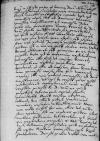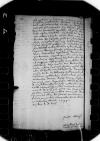Causa Cornelii perdifficilis cognitu visa est omnibus, atque ideo ad ⌊dominos terrarum Prussiae consiliarios⌋ est remissa. Inter quos cum principem locum teneat Reverendissima Dominatio Vestra, facile auctoritate sua providebit, ut quod iustum fuerit, Cornelius obtineat. Cui ego pro virili mea affui, sed aliter fieri non potuit.
In causa pupilli laboratum quidem est a me, ne quid contra eum ⌊Petrus Brant⌋ obtineret. Sed quoniam in ea, quae pupillo data est, in integrum restitutione permissum ⌊illi⌋ fuit, ut causam diceret, quamobrem restitui pupillum non oporteret, et ille ad causam hanc dicendam cum processu causae suae huc venerat, negari illi non potuit commissio ad ⌊dominos consiliarios⌋, ut ipsi de causis, quas esset producturus, cognoscerent. Cum autem ⌊consilio⌋ praesit Reverendissima Dominatio Vestra, ne quid pupillus detrimenti capiat, facile providebit.
Quod causam citatorum attinet, dici illud potest: “Parturiunt montes, nascetur ridiculus mus”. Nam non modo nihil hic cum illis, ut audio, serio agetur, sed ne oratores quidem istos mittere ⌊Gedanum⌋ deliberatum est. Sunt, qui persuadere conantur
s(erenissimae) or s(acrae)⌈s(erenissimae)s(erenissimae) or s(acrae)⌉
⌊maiestati regiae⌋, ut ipsa ⌊Gedanum⌋ proficiscatur; quod an factura sit, nescio. Nondum enim suam ⌊ipsa⌋ dixit sententiam. Deo sit gratia, valet iam melius,  BCz 1618, p. 532 sed metuo, ne in ⌊Lituaniam⌋ potius quam in ⌊Prussiam⌋ proficiscatur.
BCz 1618, p. 532 sed metuo, ne in ⌊Lituaniam⌋ potius quam in ⌊Prussiam⌋ proficiscatur.
Quorum causas Reverendissima Dominatio Vestra mihi commendat, iis adero pro virili mea votoque suo potientur.
Hic decreta est contra hidden by binding⌈[a]a hidden by binding⌉ ⌊Turcam⌋ generalis expeditio, ad quam etiam ordo noster sacerdotum consensit, ut ex aequo hidden by binding⌈[o]o hidden by binding⌉ cum ordine equestri omnia ferat onera, uno tantum hoc excepto, quod qui sacerdotes sunt, ii proficisci ipsi non tenebuntur, verum hidden by binding⌈[m]m hidden by binding⌉ alios loco sui mittere. In civitatibus quorum hidden by binding⌈[um]um hidden by binding⌉ facultates mille florenis aestimabuntur, equitem unum, quorum quingentis, peditem unum armatum expedient; tenuiores quindecimum ex numero suo, coloni vero vigesimum expedient. Lustratio fieri debex written over g⌈gxx written over g⌉ime insequentis anni festum divi Adalberti. Haec contra vim tantum Turcicam hidden by binding⌈[am]am hidden by binding⌉; contra alios leviores hostes restat adhuc hidden by binding⌈[c]c hidden by binding⌉ alia habenda consultatio.
In Daniae regis hidden by binding⌈[is]is hidden by binding⌉ causa ut dominus ⌊castellanus Gedanensis⌋ ad ⌊caesarem⌋ mitteretur, laboratum est ab oratoribus ⌊domini ducis⌋, verum frustra. Pervicit enim ⌊reginalis maiestas⌋, ut ⌊filius⌋ domini ⌊castellani Sandecensis⌋ mitteretur, homo valde iuvenis.
Ignoscat occupationibus meis Reverendissima Dominatio Vestra, per quas non licet plura hidden by binding⌈[a]a hidden by binding⌉ scribere. Cuius me gratiae commendo. Deum hidden by binding⌈[m]m hidden by binding⌉ precor, ut illam diu servet incolumem. Cuius me gratiae commendo.
 BCz 1618, p. 532 sed metuo, ne in
BCz 1618, p. 532 sed metuo, ne in 

